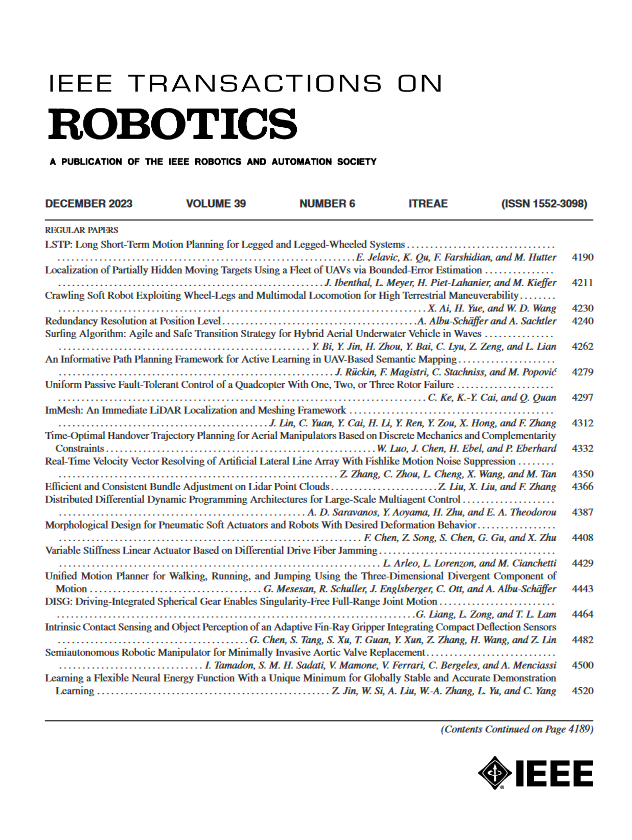仿人在摇摆刚性表面行走的时变脚位控制
IF 10.5
1区 计算机科学
Q1 ROBOTICS
引用次数: 0
摘要
动态刚性表面上的运动(即在惯性坐标系中加速的刚性表面)对控制器设计提出了复杂的挑战,这对于解决在动态现实环境中部署人形机器人(如移动的火车,船舶和飞机)至关重要。介绍了一种周期性摆动刚性表面上仿人行走的实时、可证明的稳定控制方法。第一个关键贡献是将经典的基于角动量的线性倒立摆模型从静态扩展到运动周期可能不同于机器人步态周期的摆动地面。这种扩展导致了一个时变的、非均匀的机器人模型,这与现有的摆模型有本质的不同。对该模型综合了离散阶跃控制律,并导出了一组新的充分稳定条件,验证了控制器的稳定效果。最后,在一个Digit人形机器人上进行了仿真和硬件实验,证明了该框架在处理摇摆地面上的双足运动方面的有效性,即使在不确定的表面运动和未知的外部推动下也是如此。本文章由计算机程序翻译,如有差异,请以英文原文为准。
Time-Varying Foot Placement Control for Humanoid Walking on Swaying Rigid Surface
Locomotion on dynamic rigid surface (i.e., rigid surface accelerating in an inertial frame) presents complex challenges for controller design, which are essential to address for deploying humanoid robots in dynamic real-world environments such as moving trains, ships, and airplanes. This article introduces a real-time, provably stabilizing control approach for humanoid walking on periodically swaying rigid surface. The first key contribution is an analytical extension of the classical angular momentum-based linear inverted pendulum model from static to swaying grounds whose motion period may be different than the robot’s gait period. This extension results in a time-varying, nonhomogeneous robot model, which is fundamentally different from the existing pendulum models. We synthesize a discrete footstep control law for the model and derive a new set of sufficient stability conditions that verify the controller’s stabilizing effect. Finally, experiments conducted on a Digit humanoid robot, both in simulations and on hardware, demonstrate the framework’s effectiveness in addressing bipedal locomotion on swaying ground, even under uncertain surface motions and unknown external pushes.
求助全文
通过发布文献求助,成功后即可免费获取论文全文。
去求助
来源期刊

IEEE Transactions on Robotics
工程技术-机器人学
CiteScore
14.90
自引率
5.10%
发文量
259
审稿时长
6.0 months
期刊介绍:
The IEEE Transactions on Robotics (T-RO) is dedicated to publishing fundamental papers covering all facets of robotics, drawing on interdisciplinary approaches from computer science, control systems, electrical engineering, mathematics, mechanical engineering, and beyond. From industrial applications to service and personal assistants, surgical operations to space, underwater, and remote exploration, robots and intelligent machines play pivotal roles across various domains, including entertainment, safety, search and rescue, military applications, agriculture, and intelligent vehicles.
Special emphasis is placed on intelligent machines and systems designed for unstructured environments, where a significant portion of the environment remains unknown and beyond direct sensing or control.
 求助内容:
求助内容: 应助结果提醒方式:
应助结果提醒方式:


